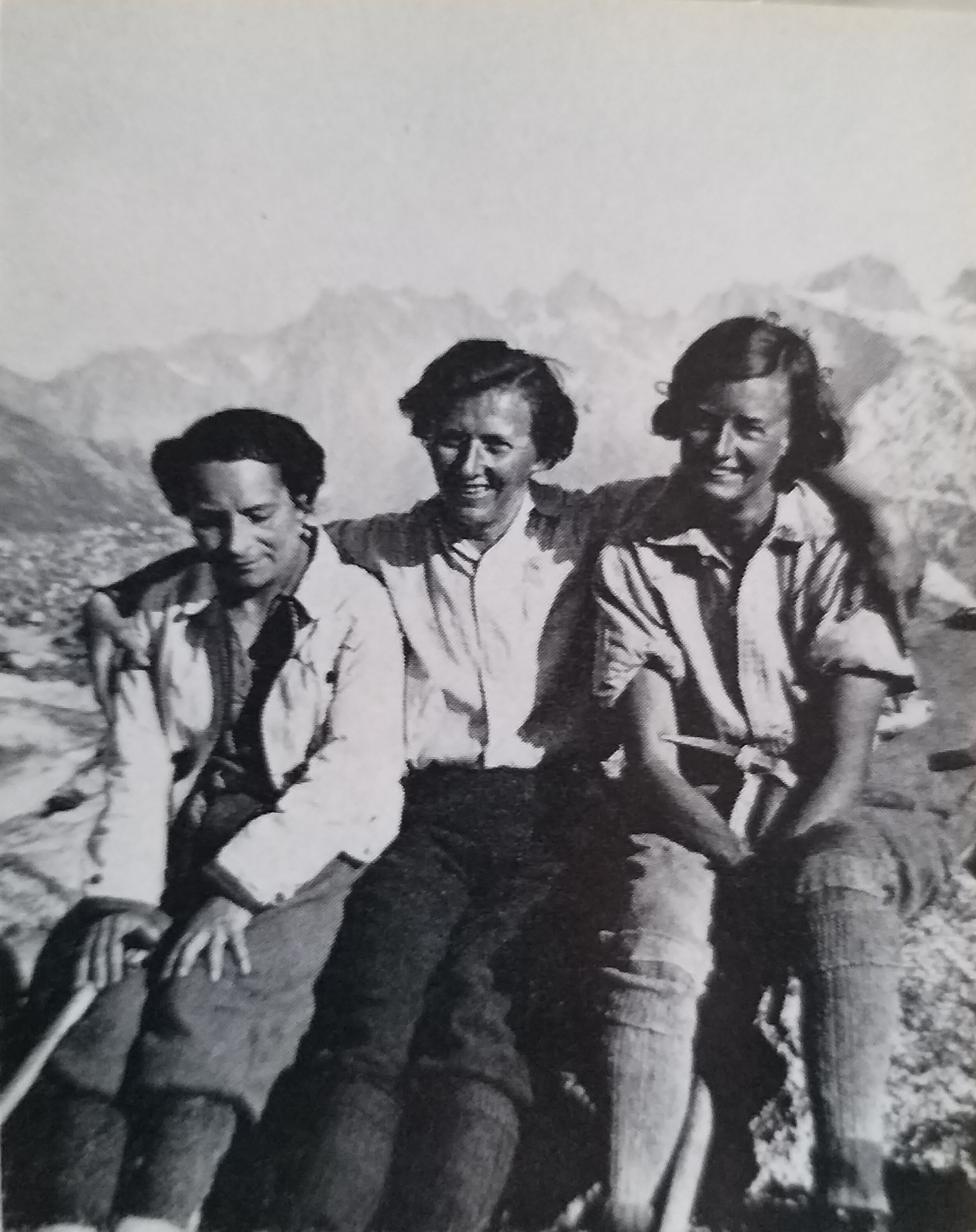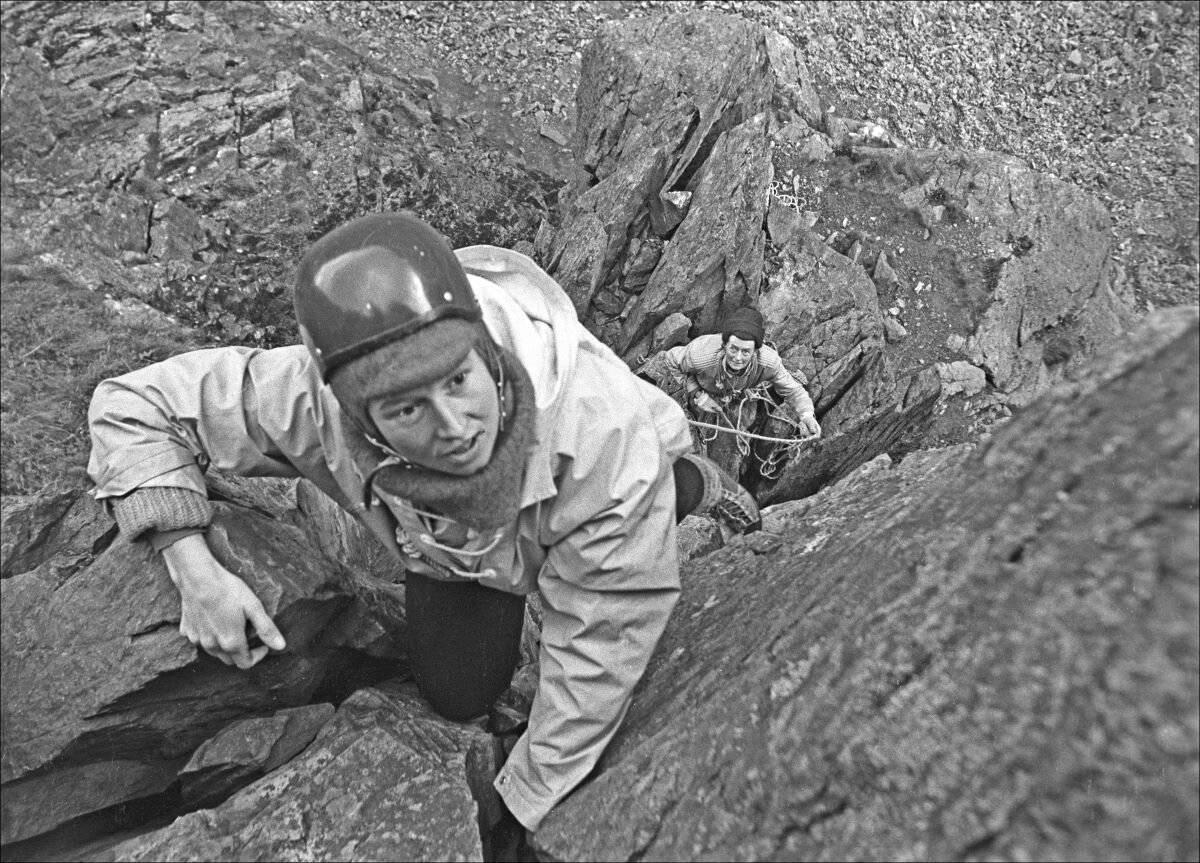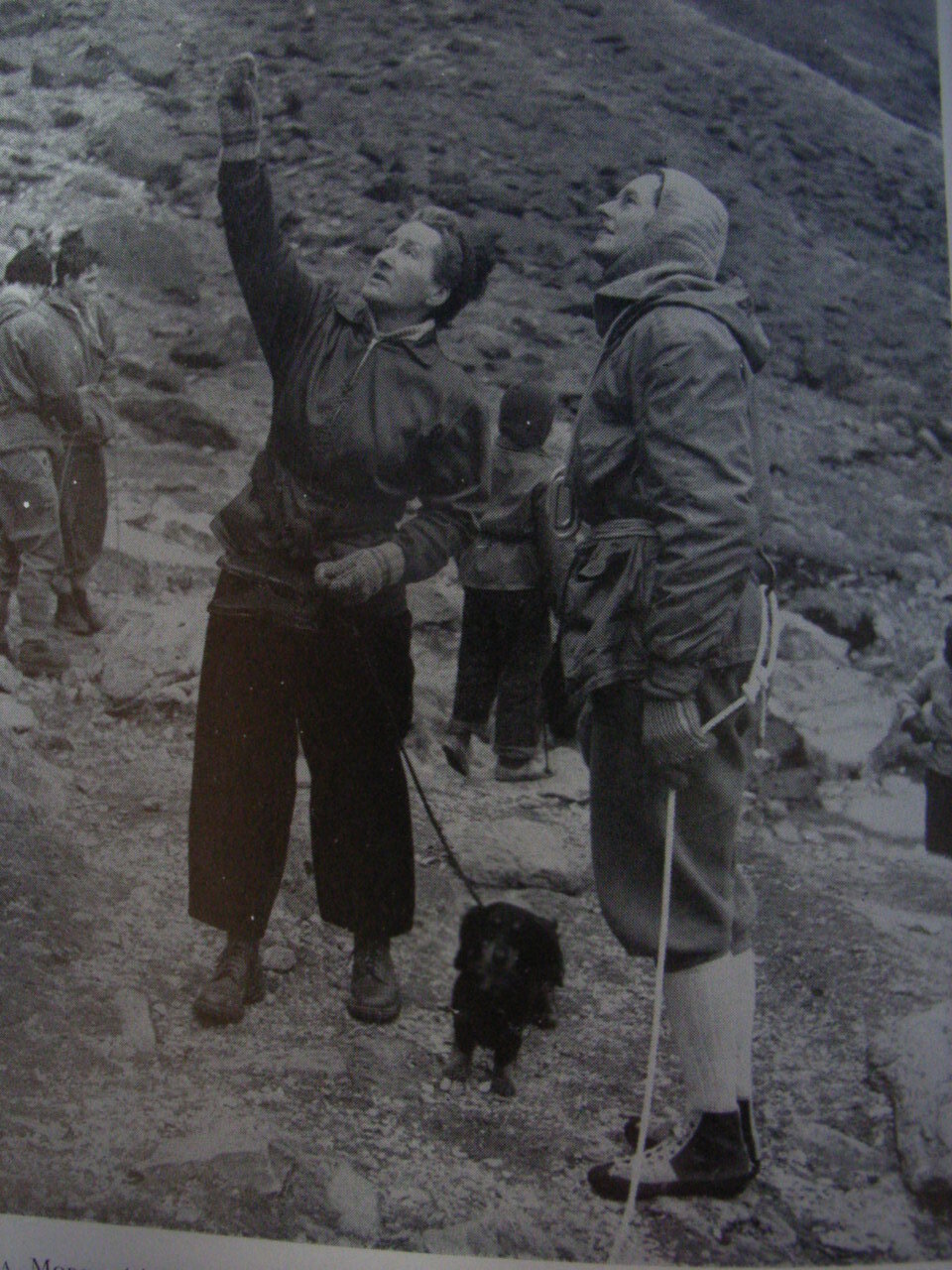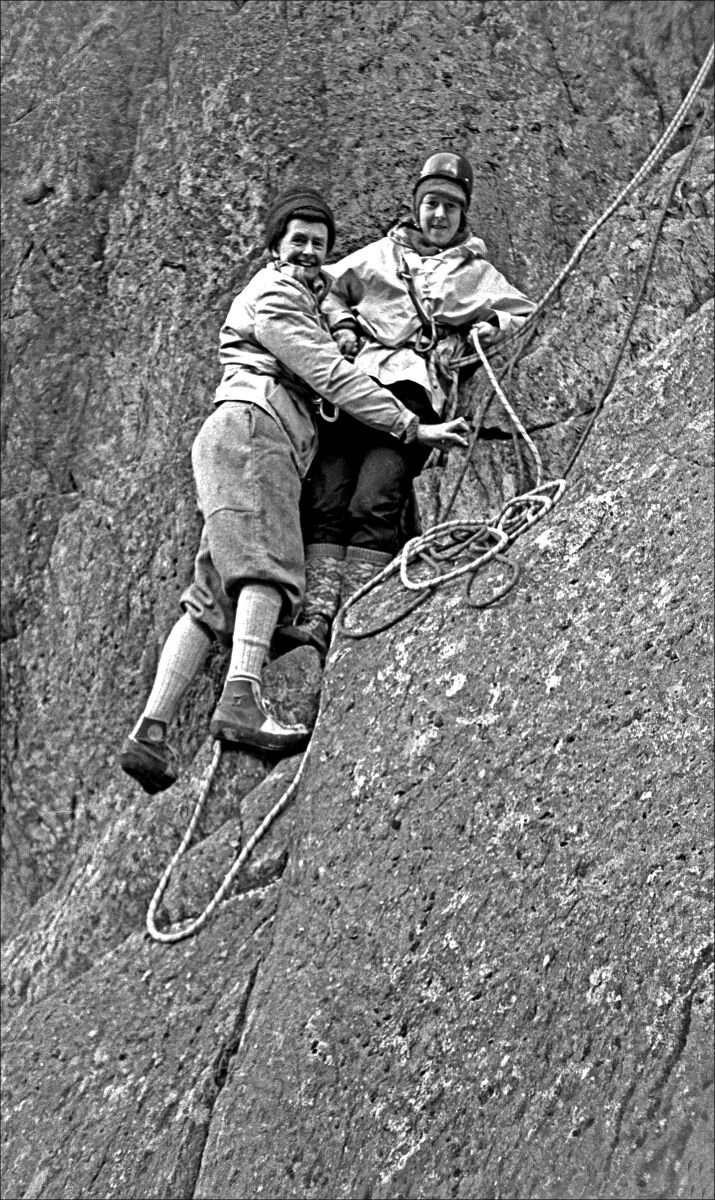Nea Morin
Nea Morin, née Barnard (1905-1986), is probably best known for her first ascent of Nea (VS) on Clogwyn y Grochan (Snowdonia) in 1941 and her first all-female ascents in the Alps. Nea’s many achievements are documented in her autobiography, A Woman’s Reach. She climbed at every opportunity — Harrisons Rocks, Fontainebleau when she lived in Paris, in Wales, Cornwall, the Alps, the Dolomites and later in the Himalaya. Climbing was Nea’s passion, but she also raised a family and passed on her enthusiasm for the mountains to her children, Denise (also a member of the Pinnacle Club) and Ian.
Nea’s first climbs, from around 1911, were on Wellington Rocks, Tunbridge Wells Common, when she was six. Her father, a member of the Alpine Club, offered sixpences to Nea and her brothers for the first to solve a boulder problem. Nea recalls some of their childhood antics in her autobiography:
“We discovered father’s Alpine rope, fixed it to a leg of the table in the nursery on the top floor, tied the other end to a tree in the garden and slid down on one of the best drawing-room cushions, thus making a sort of téléphérique. But the neighbours complained and these dangerous goings-on were forbidden.”
Nea and Osbert, Diablerets (Switzerland), 1911.
Jean and Nea on the practice slabs near the Montenvers, c1926. Credit: Miriam O’Brien.
Summers were spent in the mountains, often in the Tyrol or at Diablerets in Switzerland. Nea’s first independent holiday in the Alps was to La Bérarde in 1925 when, with Winifred Marples and guides, she traversed the Ecrins. In the same year she was accepted by the Ladies Alpine Club as a graduating member. In 1926 she was climbing with Winifred Marples in Chamonix. With guides they climbed the Requin and the Dent du Géant and made traverses of the Grand Charmoz and the Grépon. It was after their ascent of the Requin that Nea met Jean Morin at the Requin hut.
Nea’s next season in the Alps, 1927, “was full of marvellous promise”, for Jean Morin had invited Winifred and Nea to climb with him in Chamonix. There were many disappointments, but one great success — a first guideless ascent of the Aiguille de Roc on the Grépon. Back in Paris at the end of the summer, Nea and Jean became engaged and they married in 1928.
From 1933 Nea started climbing in the Alps in women’s teams, often with her sister-in-law Micheline Morin and Alice Damesme. Nea, Micheline and Alice had plans for a traverse of the Meije “en cordée féminine” (“women’s rope”). But it was not certain whether Nea’s husband Jean and Alice’s husband Maurice would leave them to climb alone on the Meije. In the end Nea, Micheline and Alice climbed as a women’s team, but Maurice and friends followed them on their ascent.
Micheline, Nea and Alice at the Aigle hut after the first female traverse of the Meije in 1933. Credit: Alpine Club Library.
Walking to the Promontoire hut: Alice, Nea and Micheline carrying firewood in 1933. Credit: Etienne Bruhl Collection.
Blaitière, Pointe de Chamonix. Alice and Nea, 1934. Photo: Micheline Morin Collection
The next ‘manless’ venture for Nea, Micheline and Alice was on the Aiguille de Blaitière (France) in 1934. This time they managed to shake off anxious husbands and brothers. Nea’s account in her autobiography conveys their excitement at going off alone:
“Alone at last! Alice, Micheline and I found ourselves on the terrace of the Montenvers Hotel, having just speeded our male friends and relatives on their way to the Requin hut, thus accomplishing by far the most difficult and trying part of our programme. All summer we had hoped to do a climb really on our own, but the way of the would-be ‘manless’ climber is fraught with many an obstacle unknown to the general mountaineering public. Several times we had been together on a rope, but always with a party of friends near at hand, as on the Meije the previous year, and under such conditions more than half the sense of adventure is lost.”
Climbing alone in a women’s team on the Blaitière had been a joyous occasion for Nea, Micheline and Alice, though they did still have offers of help and tips from a guided party ahead of them on the route. The guide was surprised to see them and still more surprised when they politely declined the offer of a rope on one of the pitches.
During the war Nea lived in Criccieth, North Wales with her children, Denise and Ian, and her mother. Most of her time was spent looking after the children, doing some voluntary work and teaching at a local school. She also did a “little climbing with friends on leave”.
Amongst the ‘little climbs’ were Longland’s Climb and Curving Crack on Clogwyn Du'r Arddu (Snowdon) and the first ascent of Nea in 1941. It was the day after climbing Curving Crack that Nea, John Barford and John Menlove Edwards went to look at some of Menlove’s problems on the Three Cliffs. Nea’s famous eponymous route on Clogwyn y Grochan is described in a couple of sentences in her autobiography:
“He (Menlove) stopped and, pointing up, said there was a good route to be made just to the right and why didn’t I go and have a look at it? I did and it went all right... The second pitch brings one to the perched blocks above Spectre, which was not climbed until six years later, in 1947, and then for some time enjoyed the reputation of being the hardest climb in Wales. The original finish of Spectre went straight up taking the last two pitches of my climb which was named Nea.”
Early during the war Evelyn Lowe invited Nea to stay at the Pinnacle Club hut which is situated close to the Cwm Dyli power station. Nea describes her arrival at the hut:
“I bicycled up from Criccieth and arrived late in the evening to find the gates bolted and barred. Negotiating various fences and barbed wire and jumping the stream I arrived at the hut feeling rather pleased with myself, only to be told that the Power Station was a place of National Importance and I was lucky not to have been shot by the Home Guard.”
Above the crux on Nea - Nea following Denise in 1967. Credit: John Cleare.
Vajolet Towers. Credit: Vincenzo Gianferrari Pini - Wikimedia
Nea joined the Pinnacle Club in 1947. As she had married a Frenchman she was technically an alien in Wales during the war, so she was not able to join until after the war. She returned to Tunbridge Wells in 1947, now a widowed mother of two. Jean had been returning from a special mission in 1943 when his plane was shot down. While the children were still young there were family holidays in the mountains. In the Dauphiné (France) in 1950 Ian climbed his first 3000m peak aged 14 and Denise climbed her first 4000m peak, the Ecrins (also France), aged 18.
During the 1950s, Nea and Denise often climbed together in the Alps and Dolomites. 1953 was a particulary good year with ascents of the Weissmies (Switzerland), the north face of the Cima Piccola di Lavaredo (Italy) and a traverse of the Vajolet Towers (Italy). The latter climb traverses three towers, the Winkler, Stabeler and Delago. In her autobiography Nea describes an encounter with an Italian party at the top of Stabeler:
“On the top of the next tower, the Stabeler, there were some Italians, who were completely nonplussed to see us climbing alone. When Denise arrived on the summit and began taking in my rope, one of the Italians stepped forward, seized it, and striking a manly attitude, proceeded to show her just how a rope should be held.”
There were other memorable ascents in the 1950s including a guided ascent of the the Schalligrat of the Weisshorn (Switzerland) in 1953 with Janet Adam Smith and an epic ascent of the Mer de Glace face of the Grépon (France) in 1955. Nea was climbing with Denise on one rope and Janet was on another rope with a guide. “Our expedition was an extraordinary affair, and I do not think I have ever come quite so close to annihilation.”
In the years 1953-57 Nea worked at Plas y Brenin instructing on outdoor courses for girls. She climbed in North Wales with her daughter Denise, John Barford and John Menlove Edwards, and made trips to Bosigran (Cornwall), Skye, the Alps and the Dolomites.
The 1959 expedition to Ama Dablam (Himalaya) was Nea’s last serious mountain endeavour. She reached Camp 1, from where she was able to assist the team by placing fixed ropes and moving equipment and supplies. For Nea the expedition was a great physical challenge but tremendously worthwhile. She had never dreamed that such an opportunity would come her way.
As well as having a brilliant climbing career, Nea also made a name for herself as a translator. In the 1950s she translated Climbs of my Youth by Andre Roch and in partnership with Janet Adam Smith she translated Annapurna by Maurice Herzog.
Nea Morin became a member of the Groupe de Haute Montagne in 1936; she was President of the Ladies Alpine Club in 1947 and President of the Pinnacle Club 1952-54. Many years later in 1981 she was elected as an Honorary Member of the Alpine Club.
Nea on the climb that bears her name, many years after her first ascent. Credit: John Cleare.
Nea on Bosigran Face, Cornwall. Credit: John Cleare.
Photo gallery
Click to move through images.













